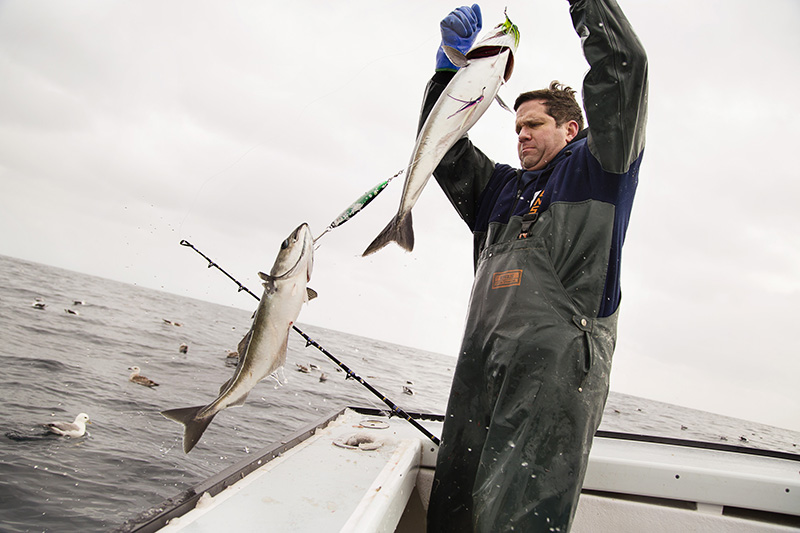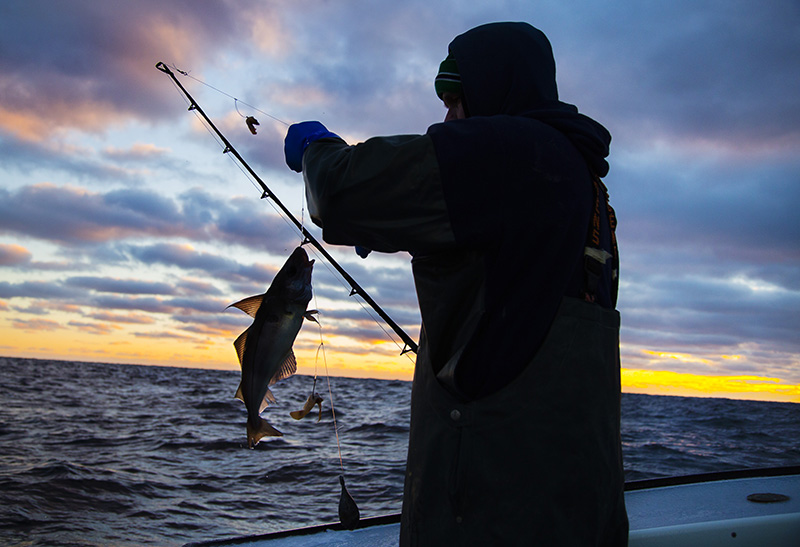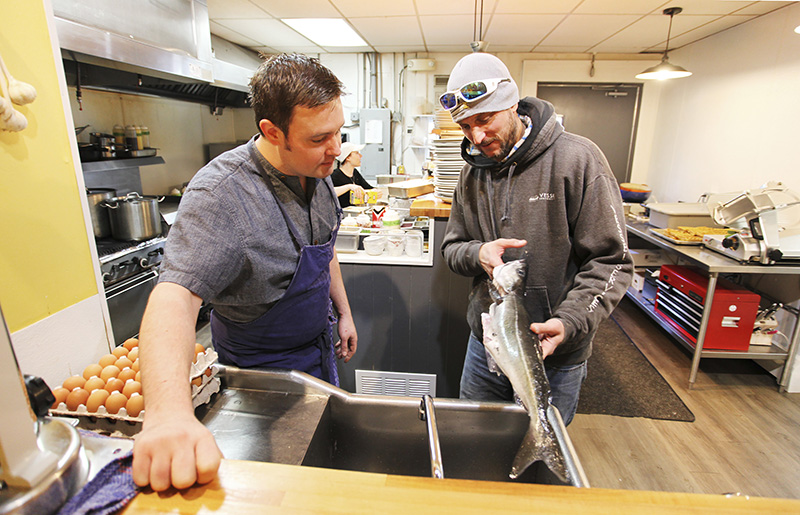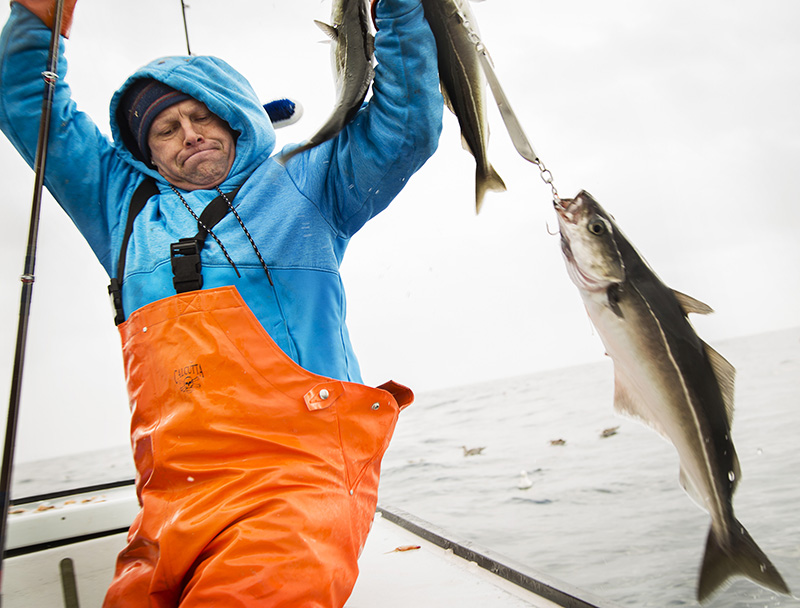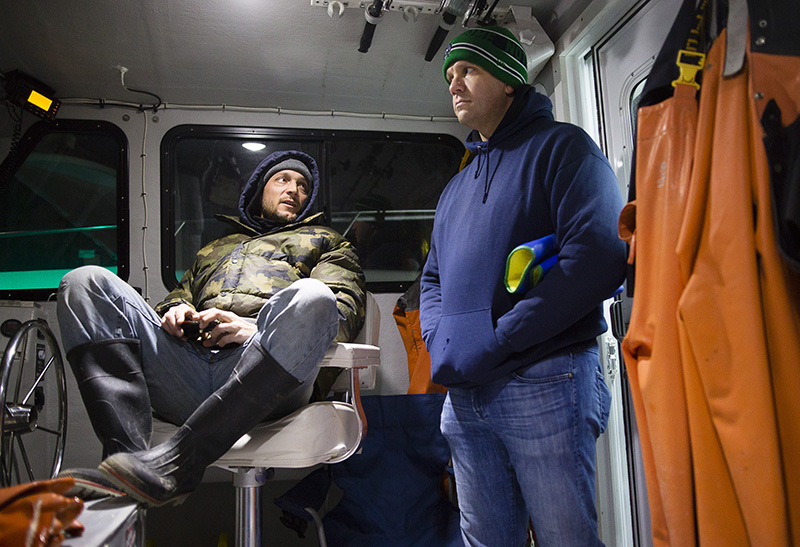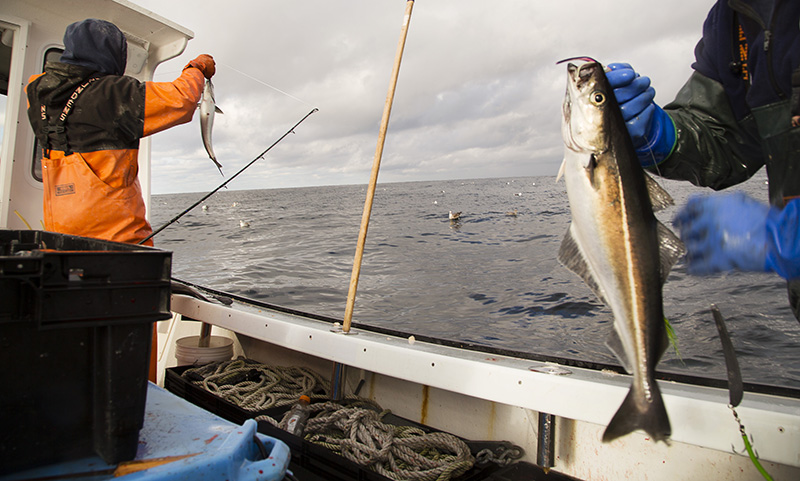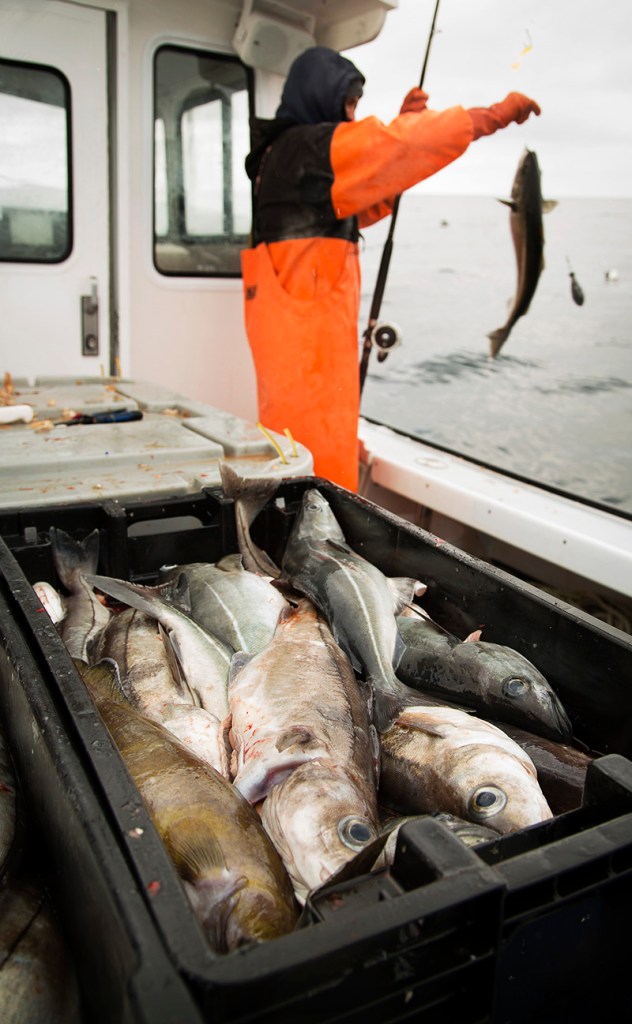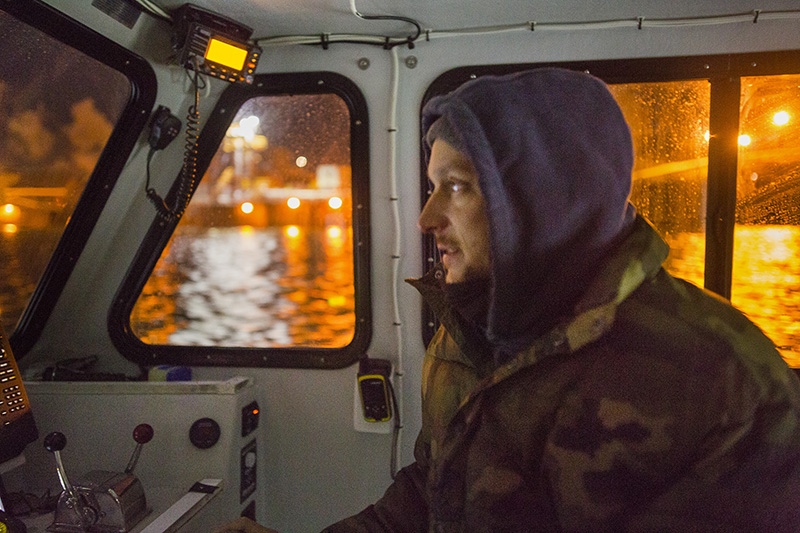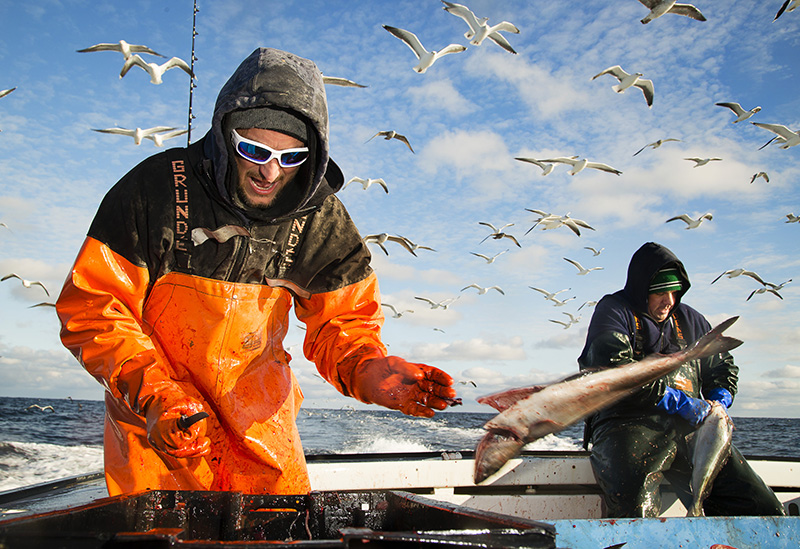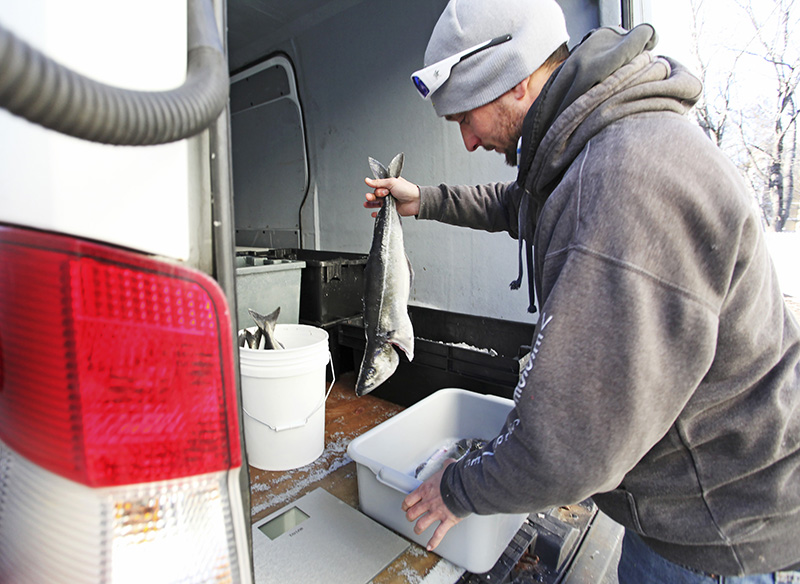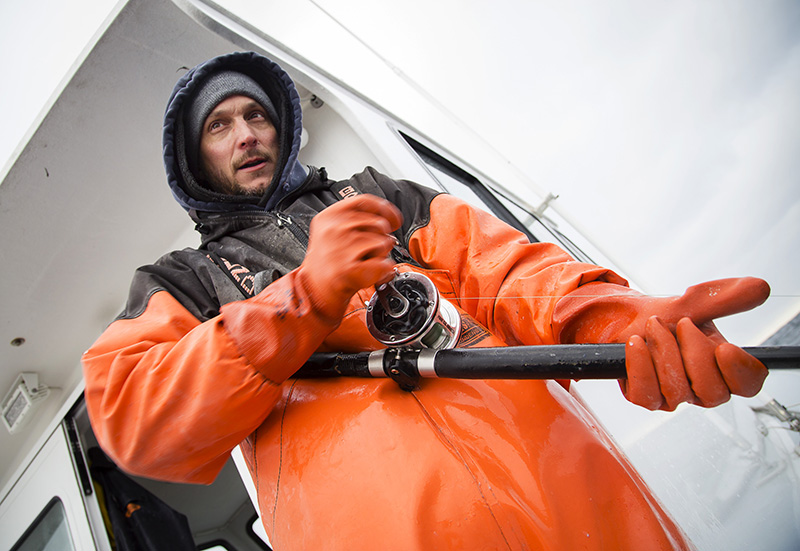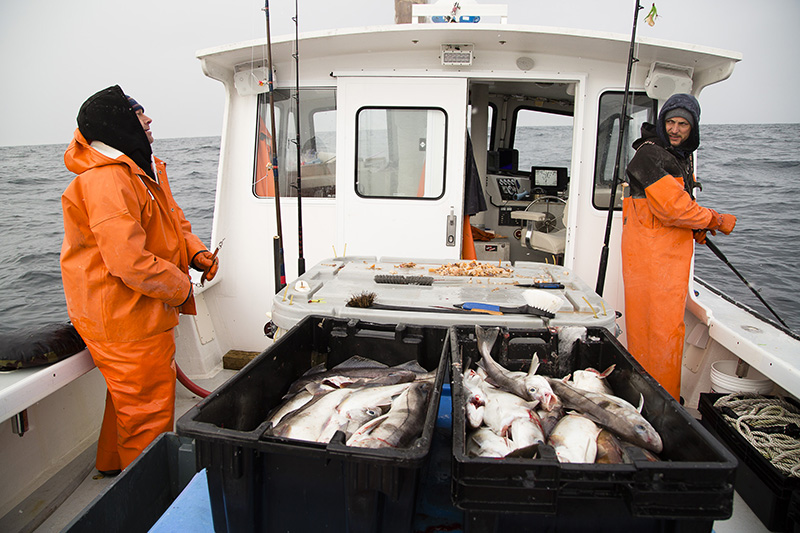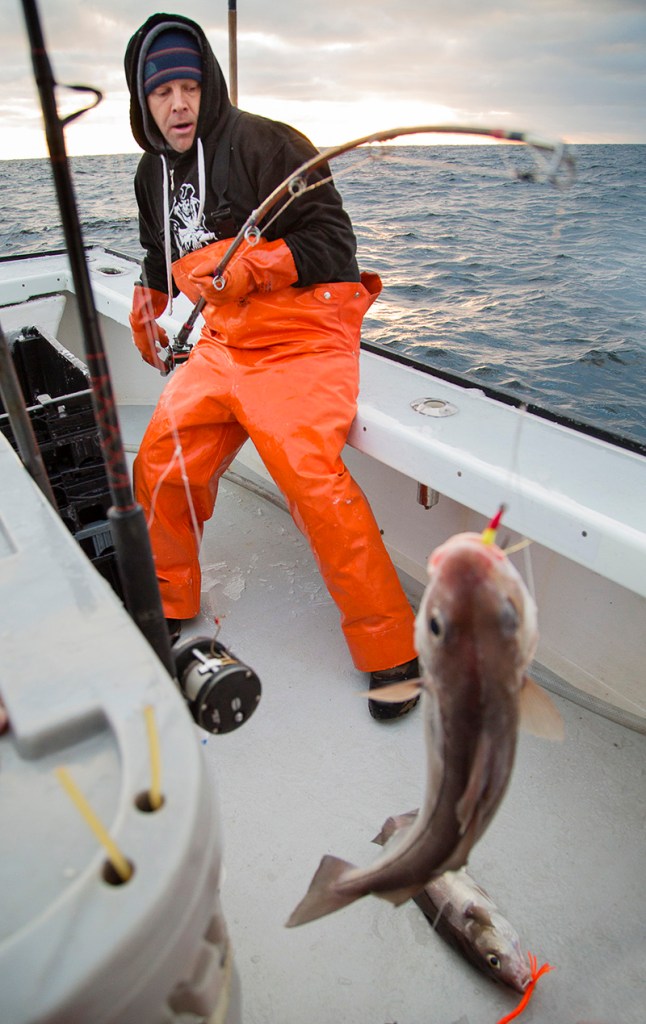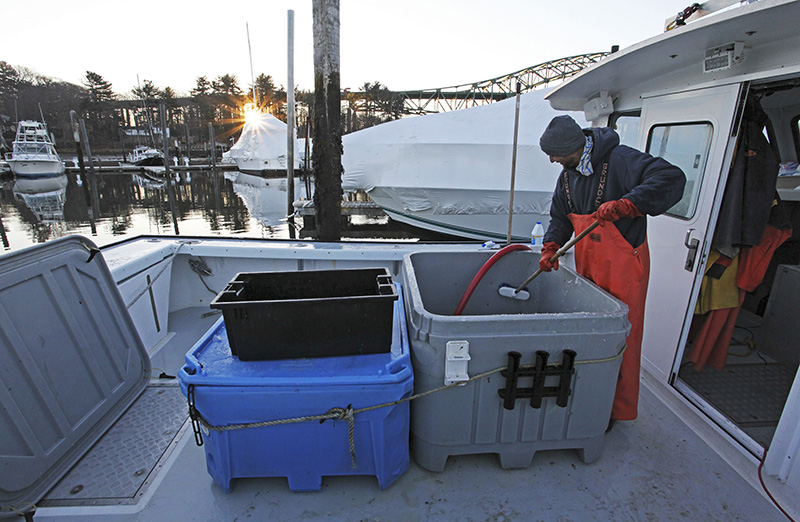Chef Benjamin Hasty, owner of Thistle Pig in South Berwick, was having a beer with a co-worker at 7th Settlement, a brewpub in Dover, New Hampshire, when he saw Tim Rider walk by, carrying fresh fish to the pub’s kitchen.
“We kept seeing someone schlepping these big totes of fish going by us,” Hasty recalled. “I said, ‘I need to introduce myself because I need to get some of that.’ ”
Hasty invited Rider, owner of New England Fishmongers, to join him for a cup of coffee. Rider told him he is one of the few New England commercial fishermen who still catches groundfish the old-fashioned way, with a rod and reel; experts believe he is the only one in Maine, and perhaps all of New England, who is doing so full time.
Hook-and-line fishing has been around as long as humanity has had an appetite for fish, though its commercial application has dwindled ever since the dawn of the industrial era, a process that accelerated after World War II. Today, most rod-and-reel fishermen find it impossible to make a living going after groundfish alone – these are bottom-dwelling species such as cod, pollock and haddock.
Rider, however, has come up with a business plan that cuts out middlemen in marketing and distribution. He directly targets restaurants and other customers willing to pay a premium of 10-20 percent for the high-quality fish he brings them just hours after landing it. He and advocates for regional fisheries hope that other fishermen will follow his lead.
Rider’s direct marketing approach has allowed him to make a living. Just as important to him, he says the way he fishes doesn’t threaten the health of the ocean or decimate fish populations. Chefs like Hasty share Rider’s environmental values, so when they met that day in the New Hampshire brewpub, they hit it off, and a business arrangement was born.
Now Hasty buys Rider’s cusk, haddock and dogfish, but mostly pollock, which he roasts and serves on top of a smoked mussel chowder. Like many other chefs in Maine and New Hampshire, Hasty practically swoons over its quality, describing Rider’s fish as meaty, ultra-fresh and far longer-lasting than fish caught by industrial boats.
“It’s just absolutely gorgeous, gorgeous meat inside,” Hasty says, “and the fish smells fresh, like this beautiful product that just came out of the ocean.”
DECK STACKED AGAINST THE LITTLE GUY
Rod-and-reel fishing brings in no bycatch, doesn’t harm the ocean floor, and, because it’s small-scale, overfishing isn’t an issue. Ultra-efficient modern fishing technology, methods such as trawls and gillnets that are used by large industrial boats, do cause these problems. But most commercial fishermen stay away from rod-and-reel fishing because the regulations for small-scale fisheries make it unprofitable, said Patrick Shepard, fisheries policy associate at the Penobscot East Resource Center in Stonington. (Small-scale fishing is defined as using boats under 50 feet that go out just for the day, as opposed to 80-foot vessels that go to sea for four or five days at a time.) Federal rules favor larger vessels that are landing volume, Shepard said.
Rider brings in about 800 pounds of fish in a day, while a large commercial trawler can bring in just as much – about 1,000 pounds – in a single trawl. Rider complains that under the current system, fishing is big business, run by large corporate interests that snatch up all the fishing quotas set by the federal government and push the little guy out. Smaller boats can lease quota from the bigger guys, but the math doesn’t always add up because what they pay for quota is often higher than what they are paid for their fish, he said, so they arrive at the dock already in the red.
Also, he added, fisheries are sometimes closed to small boats or the small boats are forced to go farther off shore than the big ones, which costs money and time and can be dangerous.
Shepard works with the resource center’s “New Entrants” program, which helps small-scale, owner-operator fishermen like Rider develop business plans for entering the groundfishing business. But so far he hasn’t had a lot of success. He says most of the people he works with – about 20 a year – end up sticking with lobstering or fishing for tuna – or groundfishing part-time only as a way to diversify – because they can’t find a way to make groundfishing profitable.
“Tim and his business model are the first opportunity that we’ve seen in a while that might actually be able to make it work,” Shepard said.
A PASSION TO SUSTAIN FISHERIES
Rider brings something else to the table, too, according to Shepard and others who know him: Passion, both for fishing and for keeping Gulf of Maine fisheries sustainable.
Mike Keegan, a Saco-based builder of custom homes who owns a tuna boat and also does “minor groundfishing,” calls Rider “the leader of the pack.”
“In the fishing industry, you’ve got two different types of fishermen,” Keegan said. “You’ve got guys who are money-hungry and don’t care about the fishery, and then you’ve got guys who fish from passion and let the money follow, and that’s Tim. I’ve never met anybody as passionate about groundfishing as Tim, not only for the business but for the fishery.”
Rider, Keegan said, will travel six hours offshore in the middle of winter when the wind chill is 10 below and “all the rods are freezing up.”
“He fishes harder than anybody I know,” Keegan said. “He’ll leave dock at midnight and fish all day and not sleep for three days.”
Rider first felt a rod in his hand at age 5, when his mother took him out for a half-day of mackerel fishing. She later called it “the worst mistake of her life, because I turned out to be a fisherman,” Rider said.
Rider has worked as crew on commercial draggers and gillnetters, and on recreational charters. He’s also owned three fishing boats. Today his groundfishing business is based in Eliot, aboard the 36-foot F/V Finlander. He sells his catch through Dover-based New England Fishmongers, co-founded with New Hampshire resident and crew member Amanda Parks.
Rider started New England Fishmongers because he was tired of dumping his high-quality fish in with the rest of the catch at open auctions, where buyers are only interested in buying low and selling high. “We’ve come back from 60 miles offshore with 800 or 1,000 pounds of fish,” Rider said, “and made enough money to maybe buy a cheeseburger.”
So he went knocking on the doors of restaurants to find chefs willing to pay a premium for his fresh fish.
Rider and his crew catch pollock, haddock, cusk, dogfish and sometimes redfish and mackerel. Under his current permit, he’s limited to 25 pounds of cod – the most desired groundfish – which translates into just two fish or so per trip.
Rider likes to say that his style of fishing “gives the fish a chance, too.”
“We just don’t have the ability to clean out the ocean,” he said.
The fish are off the hook for just hours before they are delivered personally by either Rider or one of his crew members “old-fashioned, milkman-delivery-style” to restaurants in Maine, New Hampshire and Vermont. (Rider recently added a client in San Francisco, a dealer in sustainable fish who supplies West Coast restaurants.)
Maine chefs say they believe Rider’s fish is worth the 10-20 percent premium price because the fish is handled with care.
Jake Smith, chef at The Black Birch in Kittery, calls Rider’s haddock “the freshest, most beautiful fish I’ve ever seen.” Dylan Harrigan, chef de cuisine at Robert’s Maine Grill in Kittery, said he appreciates that Rider treats under-used fish as fastidiously as other more popular fish. Few fishermen sell dogfish, for example, Harrigan said, and those who do rarely gill and gut it as Rider does. Rider’s dogfish, he continued, have “great flavor and amazing texture” and hold up extraordinarily well.
Rider says he is able to get 5 percent to 10 percent more flesh from his fish because they die immediately and then stay on ice for just a short time. Fish caught in nets struggle and suffocate, he said, and are iced for several days, factors that make them lose body weight.
Chefs accommodate the extra cost in various ways. Harrigan makes up for it by buying whole fish and using all of it, for example, making fish stock from the bones. At Thistle Pig, where fish entrees cost about $22, Hasty said he doesn’t pass the extra cost on to customers. He is more concerned with labor costs, he added.
THE PROMISE OF SMALL-SCALE FISHING
Niaz Dorry, coordinating director for the Northwest Atlantic Marine Alliance, an advocacy group based in Gloucester, Massachusetts, that champions smaller, community-based fisheries, said that the existing system looks at small-scale boats as inefficient and low priority. Fish are thought of as “pure commerce,” not as a source of “real food” for local communities. “Yet globally, (small-scale fishing) is the scale of fishing that feeds people and keeps coastal communities healthy,” she said.
Dorry likens the state of the fishing industry today to industrial agriculture before the public and policy makers began to support small-scale local farms, and restaurants started touting the sources of their ingredients on menus. (While most restaurants simply brag about buying “local fish,” 7th Settlement, which buys all of its fish from New England Fishmongers, stamps “F/V Finlander Fish Tacos” on its menu.)
One way that the Penobscot East Resource Center is trying to help rod-and-reel fishermen get back in the groundfishing game is through the Northeast Coastal Community Sector. The center manages the sector, the only owner-operator, hook-based groundfishing sector in New England. The federal government created fishing sectors as a way to ensure that the industry complies with annual catch limits.
A sector is not a geographic area but an organization of fishermen who can fish anywhere in New England as long as they have the correct permits. Each sector gets an annual allocation of groundfish quota for various species that the fishermen can either catch themselves or trade to other fishermen.
The Northeast Coastal Community Sector has 25 fishermen in the small boat category, Shepard said, but few groundfish, even part-time, since it’s not profitable. If he can make the math work, Rider would like to join the Northeast Coastal Community Sector and leave the so-called common pool, where he is subject to daily catch limits and sudden closures of fishing areas. As a member of the sector, he would be able to lease quota and continue fishing even when some areas are closed.
Shepard said the groundfish fishery has space for people like Rider. “I think that business model could work for a lot of people as long as the regulations make sense to support those small-boat fishermen,” he said.
One of the biggest expenses for groundfish fishermen, for example, is monitoring costs, Shepard said. Every time they go out fishing they must notify the federal government so that an at-sea monitor can be randomly assigned to their boat, and the fishermen have to pay for it.
“And it doesn’t matter if it’s a monitor on an 80-foot dragger that’s landing 10,000 pounds of fish or a monitor on a 36-foot boat like Tim’s landing 800 pounds of fish, the daily rate for that monitor is the same in both situations,” Shepard said. “That’s very expensive.”
‘ALL OF THOSE ARE SIGNS … THAT THINGS CAN CHANGE’
Despite the challenges, the renewed attention being paid to small-scale fishing operations has inspired at least a few others to take the leap. Mike Keegan, for one, plans to expand the rod-and-reel groundfishing portion of his business this year. For a small fee, Rider will pick up and sell some of Keegan’s fish to his restaurant clientele.
Jim LaMarche of Bedford, New Hampshire, plans to do the same. LaMarche works in technology and fishes commercially for tuna on the side. He wants to start rod-and-reel groundfishing and hopes to help Rider meet restaurant demands for premium fish.
Northwest Atlantic Marine Alliance’s Dorry says many political issues must be settled before small-scale fishing, such as rod-and-reel fishing, can expand in New England. She is hopeful that can happen. In some communities, she said, “new middleman entities” that support small fishermen are in development. She cited one company that hired a young activist as its seafood buyer who is committed to giving small-scale fishermen a fair price. Networks of “values-based” fishermen and seafood operations are starting to come together, she said.
“All of those are signs to me that things can change,” Dorry said. “Tim doesn’t have to be an anomaly.”
Meredith Goad can be contacted at 791-6332 or at:
mgoad@pressherald.com
Twitter: MeredithGoad
Send questions/comments to the editors.


